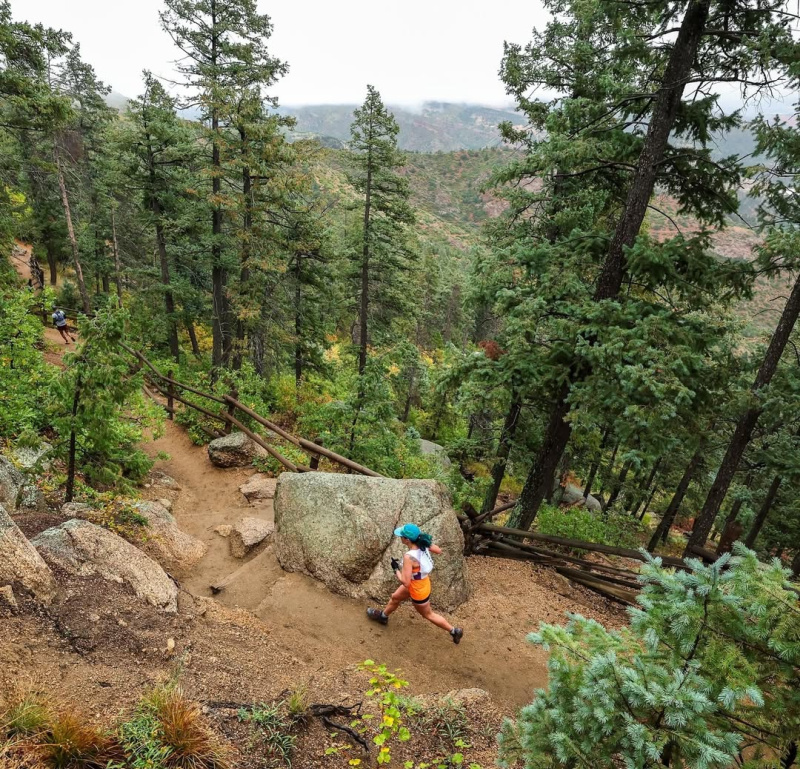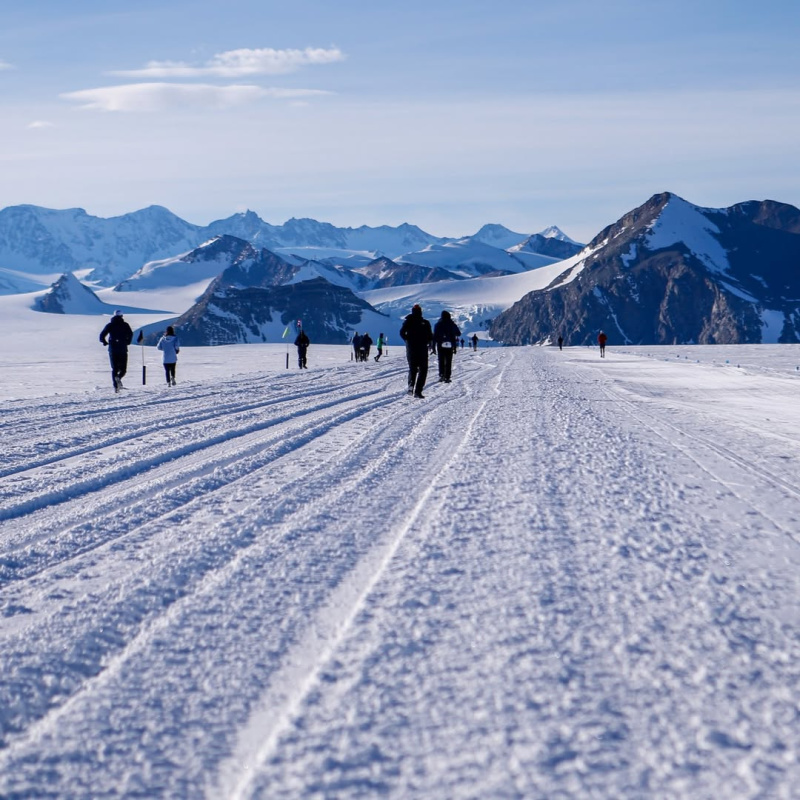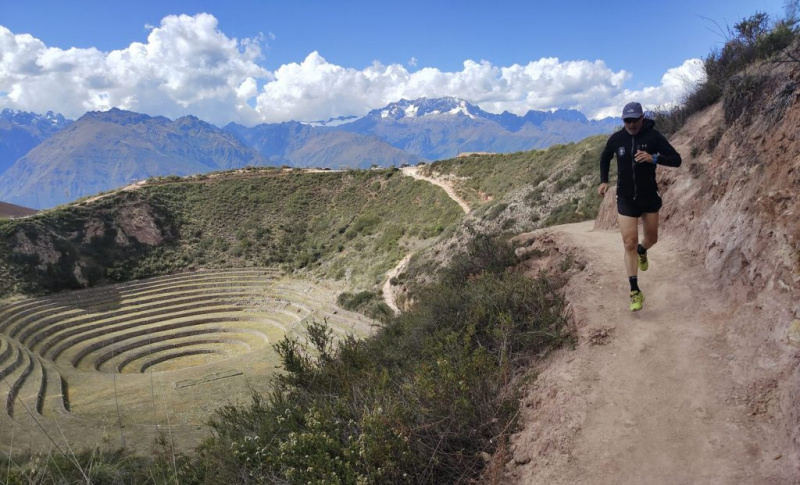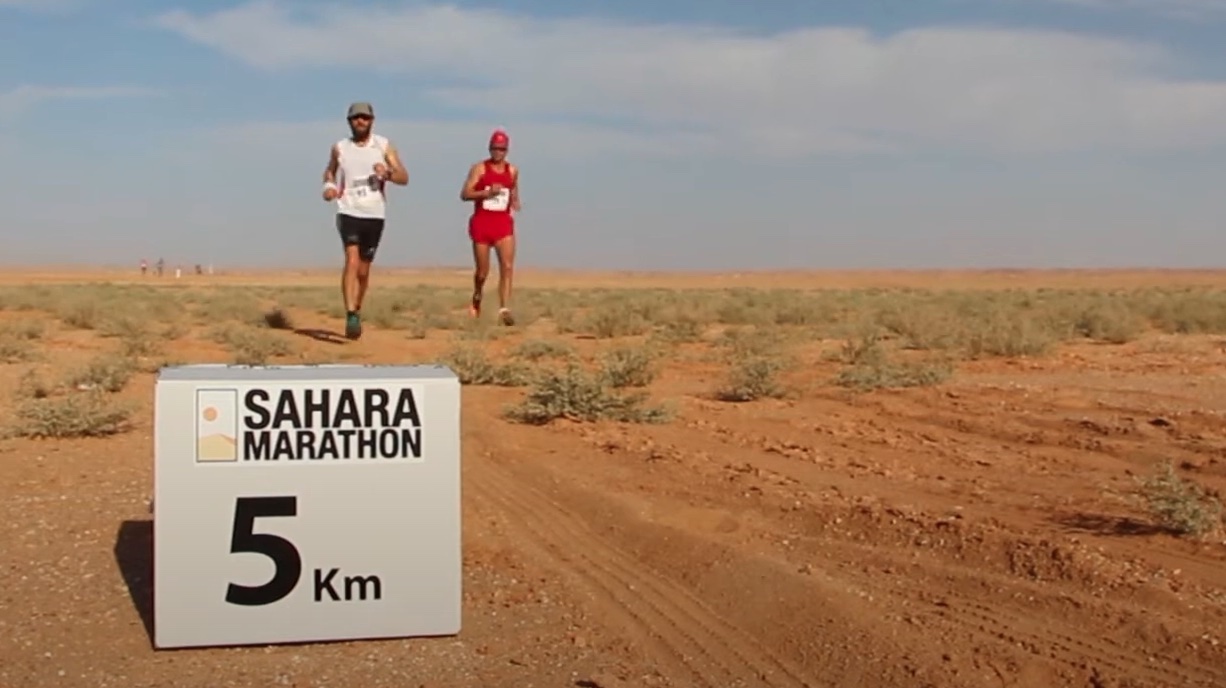Running 26.2 miles is never easy. But long time runners often find that they want a totally different challenge from say aiming for a PR or even running an Ultramarathon. Instead, they’re seeking out the hardest marathons in the world.
We wouldn’t want you to spend valuable training time searching all over, so instead our crew has gone out to cultivate that list for you! And of course a number of the athletes we train through custom 1-1 run coaching have completed many of these races!
For each we’ll give you the when, the where, the why and some feedback from other runners to help you decide!
Pikes Peak Marathon (September 21, 2025)

Where Is It?
The Pikes Peak Marathon kicks off in Manitou Springs, CO, at the base of Pikes Peak.
The trail ascends and then descends the mountain, which tops out at 14,115 feet.
What Makes It Tough?
- The trail gains 8,000 feet of elevation in just the first half of the race, and some of the spots near the summit are incredibly steep.
- The average gradient of the trail is 11%.
- The peak altitude is over 14,000 feet.
- High alpine environments are known for rapidly changing weather, so knowing how to dress for sudden changes is a must.
Other Things To Consider
- The trail consists of rugged terrain like loose gravel, rocks, narrow paths, and sharp turns.
- The average time is nearly three hours slower than the average finish time at other marathons.
- In order to enter, you have to run a qualifying event to prove you have a fitness level that can handle the trek.
Why It’s Worth It
Many who’ve completed the Pikes Peak Marathon find that the race’s significant tests of their physical and mental fortitude gave them a sense of accomplishment they haven’t felt as strongly after other races. Completing this harrowing race was a turning point that allowed them to believe they could do anything they put their minds to.
There’s also a strong sense of community among the runners and volunteers, as well as those runners who have completed it in the past.
MarathonMary had nothing but positive things to say after her experience:
This was a dream come true for me! I had saved it for my CO race state and was waiting….well I just decided it was going to be my year! Then COVID hit and I was worried it was not going to be my year……well it was the best year to do it! I had lots of time to train, ran every hill in PA and hoped for the best! It was absolutely amazing!!!! If you are debating….just do it! You never know how you will do unless you give it a try! I was a rock star on the ascent…however what killed me was the downhill! I didn’t train for that and it was hard on my body….but I did it! The town was awesome and just super cute! So much to do, I probably did too much after the race, including the incline and hiking Pikes from the other side a few days later! I guess I’m a mountain junkie 😉 Loved every minute!!!
Kilimanjaro Trail Marathon (August 30, 2025)

Where Is It?
The Kilimanjaro Trail Marathon begins at Ushirika Stadium at Moshi Cooperative University in Moshi, Tanzania, before winding through trails near the base of Mount Kilimanjaro.
What Makes It Tough?
- This is another altitude run, so if you’re not experienced with that aspect, training is a must.
- The temperatures in Tanzania are sweltering, with race day highs easily reaching 100°F.
- You’ll ascend around 9000 feet in altitude during the first part of the race.
Other Things To Consider
- Getting to Moshi can be a trek for marathoners coming from other parts of the world, so you might want to combine your marathon with a few extra days to see the sights while you’re there.
- The road is not entirely paved and you’ll face terrain changes along the way.
- The course is a loop that runners complete 4 times to finish.
Why It’s Worth It
Not only is Mount Kilimanjaro breathtaking, runners will also be treated to views of banana and coffee plantations and local villages along their way.
After the race, many runners choose to stick around and enjoy the vibrant culture and sense of community as they immerse themselves in Tanzanian culture.
Runner chimikey says it was harder than he expected:
First, this should be a called a “Trail” run, as it seems 20 of the 26 miles is off road with extreme undulating elevation, and you’re already at over 2000′ elevation! It’s been a while since I’ve lost a toenail, but I’m losing both big toenails real soon, a small percentage of this could be attributed to my shoes not being 100% broken in yet, but most of this comes from the hilliness and off-road part, I just wasn’t prepared or expected it. A very polite, happy, proud and respectful country.. I’m glad I did this and am kind of glad I didn’t know how hard it would be going into it, ignorance is bliss, my happy place.
Tenzing Hillary Everest Marathon (May 29th, 2025)

Where Is It?
The Tenzing Hillary Everest Marathon, named in honor of the first men to successfully summit Everest, takes place in the Solukhumbu region of Nepal. Sir Edmund Hillary and Tenzing Norgay, his Nepalese sherpa, accomplished the feat on May 29, 1953.
Marathon runners take off from Mount Everest Base Camp and finish their race at Namche Bazaar.
What Makes It Tough?
- The starting point, Everest Base Camp, is at an elevation of 17,598 feet, and is the highest starting point for any marathon in the world.
- Runners rountely contend with altitude sickness or low oxygen, even if they consider themselves acclimated to running in high altitudes elsewhere in the world.
- The terrain is varied and challenging, and includes glaciers, steep climbs, and rocky paths.
Other Things To Consider
- The route is considered marginally dangerous, with a higher-than-usual chance of slipping or contending with rockfalls.
- Weather conditions can change rapidly, with snowstorms and extreme cold being routine in the area.
Why It’s Worth It
The marathon route follows historic Sherpa trails of the Khumbu Valley, so if you’re a history buff, this one definitely offers a little something extra.
The views are awe-inspiring and include many Himalayan peaks, including Everest, Lhotse, Nuptse, and Ama Dablam. Runners are also able to spot monasteries, villages, and forests, and offer the opportunity to glimpse Sherpa culture and traditions.
Runner chimikey says it was a huge commitment, but worth it big time:
This is a 3 week commitment.. held every May 29, the anniversary of the first climbing, about a 12 day hike (a couple rest days) to the start line.. the altitude and terrain is a great equalizer. It’s the hardest thing, emotionally, physically and mentally that I’ve ever done. I’ve never quit a marathon, as my kidneys were shutting down.. I wanted to quit, but there was no where to quit to.. I finished in darkness, about 3 hours past what I wanted.. the most beautiful views ever.
Antarctic Ice Marathon (December 13, 2025)

Where Is It?
The Antarctic Ice Marathon begins at Union Glacier, around 600 miles from the South Pole.
This race is considered the southernmost marathon on Earth.
What Makes It Tough?
- Temperatures can dip very low, making frostbite and hypothermia very real concerns.
- The race is run on snow and ice, so falls and slips are a regular occurence.
- The terrain is uneven and hard to predict, since no one is familiar with it ahead of time.
- Weather conditions are a factor, with strong winds, snow flurries, and blizzards influencing the course.
Other Things To Consider
- Between the terrain, the weather, and the all-around harsh conditions, this marathon is a significant physical challenge.
- The remote location is difficult to access, and makes it challenging to access medical support.
Why It’s Worth It
Completing this race is an achievement like no other, and the unparalleled challenge draws extreme adventurers from all over the world.
While the toughness of the Antarctic Ice Marathon is one of the biggest draws, the breathtaking, stark beauty of the region is something most people will never see with their own two eyes. Runners say the vastness of the landscape provides a sense of humility, and the memories and camaraderie found on the ice are sure to last a lifetime.
If you’re someone who has a “seven continent challenge” on your bucket list, this is certainly a good way to check the hardest one off the list.
This guy wouldn’t do it again, but he’s happy to have done it once:
Our Zodiacs (rubber rafts) the ship about 11:15 and we sat for a bit off-shore while Wave 1 folks finished and boarded an adjacent Zodiac. Once 10 we’re off the island, the next 10 could land. Once on land, we shedded our “Antarctica Gear” (rubber boots and waterproof pants and parka) and put on our running shoes as quickly as possible. No warm up time; we had about 5 minutes to line up.
6 laps for the marathon along a gravel/dirt/mud road. The footing was very good and we only had a couple of unavoidable muddy patches. On this part of KGI there is no snow this time of year (end of Summer), but lots of streams from the visible melting glaciers crossed the road. I had brought two pairs of trail shoes, one more rugged (with gaiters!), but could have used a solid road shoe. My lightweight Adidas Terrex race shoes were perfect for the conditions.
The views were spectacular and served as a constant reminder that we were in a very special environment. The sun turned the bays into a beautiful dark blue color and there were stunning glaciers and rock formations around every curve. It was breathtaking.
And good thing it was, as this course was a monster. We had lots of time to admire the views. The total climb was over a mile, with multiple hills that forced sub-3hr runners to walk (after the first joyful lap, at least). It was merciless. Hill after hill, with only about ¾ of a mile of relatively flat course (<4% grade) each way toward the Uruguay turn-around.
The last lap was met with curses, but I reveled in telling myself that this was the last time I’d have to climb each hill along the way. I ran the last mile through gritted teeth and tears, having completed the hardest physical event of my life.
The staff and supporters rushed me out of my shoes and into my boots and parka (I’m SO appreciative to not have to change on my own) and I was rushed into a Zodiac and back to the ship.
Am I glad I did it? Heck yeah. Would I do it a second time? No way.
The difficulty of this was off-the-charts. If the weather wasn’t perfect, I don’t think many more than half of the runners finish under the time cutoff. As it was, some runners were allowed to exceed the time cutoff only because of the warm weather. Those who miss the cut-off time receive “NFT” yet get “credit” for checking this continent off their list (Marathon Tours “owns” the Seven Continents Club thing, so they get to make the rules.). It was a very expensive trip, though decent value for the money. It wasn’t “running across glaciers,” which I’m sure is some folks’ idea of what this should be, but I’m grateful for that in hindsight.
The sense of accomplishment here is pretty close to what I felt after my first Marathon. It was unforgettable
The Inca Trail Marathon (August 27, 2025)

Where Is It?
Considered by some to be the most difficult marathon in the world, the Inca Trail Marathon begins near the village of Ollantaytambo at the KM82 checkpoint, which has an elevation of approximately 8,650 feet.
Most runners arrive in Cusco, Peru before the race, and then take private transportation 2 hours to the checkpoint.
What Makes It Tough?
- The high altitude means thinner air and lower oxygen levels, and without proper training, runners are likely to get altitude sickness.
- The terrain consists of a 500-year-old cobblestone path that’s uneven and steep. It also traverses rocky terrain with steep drop-offs.
- The elevation gain throughout the course is significant, as the trail includes two mountain passes over 13,000 feet, and two other peaks around 12,000 feet.
- The weather conditions are hard to predict and fluctuate between day and night to the tune of 60-70 degrees.
Other Things To Consider
- This is an extremely demanding race physically, and your training will have to include high altitudes, challenging terrain, and elevation gains and losses.
- There is also limited room in the marathon and the spots sell out quickly.
- Time and money will play a factor, as experts recommend spending several days in Cusco to acclimatize to the altitude and environment.
Why It’s Worth It
This might be one of the most difficult marathons in the world, but there’s no question among those who have run it that the time, expense, training, and travel are all worth it.
The Running the Inca Trail not only allows breathtaking views of the Andes Mountains, cloud forests, and ancient ruins, but it gives runners the chance to connect with a piece of history in the process. It culminates at Machu Picchu, a UNESCO World Heritage site and one of the New Seven Wonders of the World.
Runner dougiefres1 definitely agrees after seeing it for himself:
Billed as the world’s toughest marathon, it lived up to the expectations. You cover over 10,000 ft of elevation gain over the course including Dead Woman’s Pass at 13,800 ft. If the altitude doesn’t get you then the multiple uneven stone steps will. Beautiful course with finish at Machu Picchu. Great tour and support with Erik’s adventures. Strict 12 hour cut-off to finish in one day-otherwise spend a second night on the trail to finish the next day.
The Sahara Marathon (February 25, 2025)

Where Is It?
The Sahara Marathon begins at the Western Sahara Refugee Camps near Tindouf, Algeria.
The starting line is near El Ayoun and ends near Morocco, Western Sahara, and Mauritania, at Smara Camp.
What Makes It Tough?
- The desert is known for intense heat, with temperatures averaging around 104°F during the day while dropping to much colder lows during the night. This can cause runners to struggle with dehydration and heat exhaustion.
- The terrain is sandy, though there is a paved stretch of about 5K. The sand is hard packed in some places and loose in others, and moves from flat to rolling dunes.
- Staying hydrated can be a challenge, since aid stations run low on water and don’t always stock snacks like carbohydrates.
Other Things To Consider
- The race is isolating and the conditions are harsh, which can take a psychological toll on a runner in addition to a physical one.
- Competitors stay with families in the refugee camp before the race.
- Conditions are fairly primitive, and some might not enjoy the latrines or the cuisine offerings in the camp.
- There will likely be a language barrier with your host Saharawi family.
Why It’s Worth It
Those who’ve participated in the Sahara Marathon feel a sense of adventure traveling through such a remote, hostile landscape.
Runners also have the privilege of experiencing Sahrawi culture. The marathon raises awareness and funds for these refugees, who have lived in exile since Morocco invaded and occupied Western Sahara in 1976.
People who complete this race often feel a sense of camaraderie that turns into lifelong friendships and intense connections with the Sahrawi people.
Also, participant YanisNanashi says it’s a run he’ll never forget:
Running the Sahara Marathon is one of the best experiences ever. You stay with a family in a refugee camp in the south west of Algeria together with runners from all over the world. The spirit is amazing and so is the race. The weather was awesome for the first 20 km, getting warm and even hot for the last part of the course. The Sahrawi people were cheering like crazy and everyone was having fun. Amazing team spirit! Nice T-Shirt and a handmade medal! Awesome race!!!
Great Wall Marathon (May 17, 2025)

Where Is It?
The Great Wall Marathon starts and ends at the Huangyaguan section of the Great Wall of China in Tianjin province.
The race takes runners along a section of the wall itself during a challenging loop that travels back and forth from Yin & Yang Square.
What Makes It Tough?
- Runners traverse 5,164 historic stone steps of varying heights and widths.
- The terrain is challenging with sections of loose stones, gravel, crumbling walls, missing steps, and sections of the wall that are in need of repair.
- There are significant elevation changes throughout the race, with both steep inclines and steep descents.
- The “goat track” is an extremely steep ascent that’s part of the course.
Other Things To Consider
- The race is run in both high heat and high humidity.
- The weather can be unpredictable, which can create slippery terrain or require additional weather gear.
Why It’s Worth It
The setting and scenery are picturesque, with stunning views of both the Great Wall and the surrounding countryside. Runners also get a glimpse into ancient Chinese history and can interact with villagers along the route.
The event offers many optional tour packages along with their registration, so runners can also take time away from race day to explore Chinese culture and history.
Participant Erk.M.Hernandez describes a race he’ll never forget.
This was a really tough race but amazing to have done! Getting to run on the Great Wall was something to never forget; the first mile takes you up a mountain and then when you get to the top you get to climb up on the wall to one of it’s tallest peaks and down again. By the time you finish that you think: I’ve run at least half the race already, but no, only 4 miles! The rest of the course keeps you on street level and you run through a local country/mountain village. You really get to see the local people and experience a race like none other.
Looking for more interesting races around the world?
Check out these guides we’ve put together!
The post 7 Most Difficult Marathons In The World And Where To Find Them appeared first on RunToTheFinish.
from RunToTheFinish https://ift.tt/HdF0EUf




